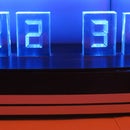Introduction: Super Wood Controller - a Piece of Wood and a Piece of History.
(Super Wood Entertainment Systems)
The Super Wood Controller is a fully functional PC gamepad with wood housing looking like the legendary "Super Nintendo Controller". The Super Wood Controller can connect over USB to any computer in order to act as a Plug&Play HID (Human Interface Device).
At the moment I am building a complete Super Nintendo System out of wood. I have one gamepad ready and some others following. The Console for itself is also in the making but still in raw version...
I will show how I build the first prototype of the gamepad in this instruction. In addition I will give a little preview for the rest of the project at the end.
The gamepad is build out of lasercutted plywood and electronic parts from a USB SNES gamepad which I purchased on the internet.
I took away all the plastic housing parts from the USB gamepad and arranged them into stacked sheets of plywood. The buttons are also made out of wood and the wire is insulated by a wood cord.
The next days I will upload a video with the gamepad in action!
Step 1: Parts and Tools
Wood Case:
- Thin plywood (4mm)
- Wood cord (for the wire)
- Wood sticks (as distance piece to mount the circuit in the right distance to the wood top, but you can use anything like a short piece wood)
Electronic Components:
- SNES Gamepad USB replica
For example:
https://www.amazon.de/CSL-Gamepad-Controller-Noteb...
(German market)
https://www.amazon.com/SNES-Retro-USB-Super-Ninten...
(Us market)
- Wood paint & finisher
Tools:
- Hot-glue Gun
- Transparent all-purpose glue
- Screw Driver
- Small wood file
- Vector program
- CO2 Lasercutter(, CNC mashine or anythin else with exact cutting results)
Step 2: Extracting the Electronics
First, you have to order a standard SNES gamepad replica with USB connection from any shop. Then just open the housing by removing the screws at the back. This is the easy part, just make sure you keep the electronic board, the buttons and the rubber layers between the plastic buttons and the circuit board.
Pay attention to the direction in which the rubber layer is placed on the board. I figured out that it is the easiest way to glue the rubber layer directly on the circuit board with the hot-glue gun. Make sure that the contacts of the rubber layer are placed on the corresponding contactors on top of the circuit board!
Another thing which I didn’t think about while building the first prototype was that the a, b, x, y buttons have a little appliance integrated in the top layer of the plastic housing which makes sure that the buttons do not turn around. I didn’t integrate such a holding in my wood case but I think it would be easier anyway to just also glue the buttons on top of the rubber!
The first gamepad I ordered came with little tactile buttons as top buttons for the gamepad. The one on the picture is a newer one and has little circuit boards with a layer of rubber and a plastic button connected with small wires. I replaced them also to tactile buttons by cutting the little circuit boards away and soldering tactile buttons onto the wire. It is much easier to integrate the tactile buttons later into the frame than the original ones.
Before you can start to manufacture the wood housing you have to measure the width and the length of the circuit board. The boards you can order in the web are more or less the same but there are little differences between the models, so it is better to measure the diameter to adapt the wood housing.
Step 3: The Wood Case
I took a picture of an old SNES gamepad and made a vector graphic out of it with a vector program. Then I made one piece for the back of the gamepad and a small frame. I scaled the whole gamepad up until the circuit board fits inside the frame easily!
I used a CO2 Lasercutter from a makerspace called “Happy Lab” in Vienna (Austria) to craft the parts out of plywood.
You have to try out the best settings for cutting and engraving but to lower the damage I find out it is a good and easy way to place some crepe tape (residue-free removable) on top of the wood before lasering. You can’t see the tape on the picture because this was the time before I figured out how magical crepe tape is. The crepe tape is also a good choice to keep the small buttons and the top part together.
To get the right thickness of the housing you just have to produce a few of the third part and stack them on top of each other until you reach a height which is sufficient for placing all the electronics inside the housing! When you have an engraved top part, all the buttons, the bottom part and a bunch of the third part, you are ready for the next Step.
Step 4: Wedding
This is the tricky part...
First you have to start with gluing the wood buttons on top of the original plastic buttons. Therefore you should use strong all-purpose glue or good old hot-glue.
Now we get to the preparing of the remaining housing parts. To get enough thickness for the housing I had to stack four sheets of the frame part on top of each other. First I started with gluing two frame parts together then the other two parts. The SNES gamepad as in addition to the x, y, a, b, select, start and cross button on the front side two push buttons on the top side. For these I had to file away two little squares with same diameter as the tactile buttons. You have to measure out the diameter of the tactile buttons you use and then make an adequate opening into one or two of the frame layer (one or two, depends on the diameter of the tactile buttons). Furthermore you need an opening for the cable so you have to file away each half of a circle into each frame bundle. Now you have to glue one of the frame bundles on the wooden front part and one of the bundles on the wooden bottom part. Place the frame with the openings for the tactile buttons on the wooden front part!
Now mount the circuit board on the backside of the top part. Calculate the right distance where the wooden buttons are one half outside the top part and use a small piece wood stick or anything else as distance piece. I used wood sticks because they are easy to cut in pieces without a saw or lasercutter. Now glue the tactile buttons also on the backside of the front layer and inside the openings in the frame.
In the next step you have to think about how you want to join the front ant the bottom part. I didn’t want to use screws so I glued the two pieces together permanently. I also tried to make a magnetic connection to have the option to open the case later but this was not stable enough so I glued all together. But you may use screws or a better magnetic solution.
Step 5: Style Up the Wood
Now it is up to you what colour or look you prefer. Raw poplar plywood look has its own charm but you can easy get a classier look by just colouring up the thing. I did not use any glaze, I just coloured the wood with a special marker. Also the backside is just coloured with different brown markers, but the result is more like burned wood or something like this. You may produce a few of the wooden top parts and try out what paint or glaze gives the best look for you. I did the painting after the cutting and engraving but I think it is in some case easier to do the painting before cutting.
Step 6: Transform Plastic Wire to Wood Cord
To perfect the whole thing I recommend using a wood cord, like hemp rope or something like this, to surround the black plastic wire. This was really a mess when I wrapped the cord with a lot of glue and patience around the wire. This took me hours and everything around me was glued together in the end, so ideas for improvement are always welcome! :)
Step 7: Preview
At the moment I am building some more gamepads and a wireless version. As you can see on the picture, the Super Wood Console is also in the making... I will upload some pictures when it is ready!




